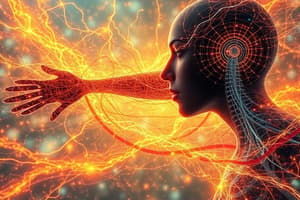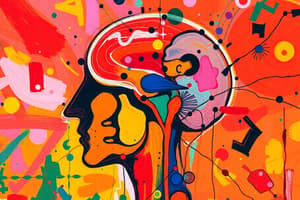Podcast
Questions and Answers
Why is it recommended to submit questions every week?
Why is it recommended to submit questions every week?
- To meet the deadline
- To cover the breadth of the question
- To avoid late submissions
- To ensure answers are in the system (correct)
What is the latest possible submission deadline for the assignment?
What is the latest possible submission deadline for the assignment?
- Friday the 17th of December @ 12 noon (correct)
- Thursday the 16th of December @ 12 noon
- Friday the 10th of December @ 12 noon
- Saturday the 18th of December @ 12 noon
How many words are recommended for describing theory x and theory y?
How many words are recommended for describing theory x and theory y?
- Approximately 75 words for each definition
- Approximately 50 words for each definition (correct)
- Approximately 25 words for each definition
- Approximately 100 words for each definition
What is the recommended word count for describing the functional role of brain region x?
What is the recommended word count for describing the functional role of brain region x?
What is the top area of the sensorimotor hierarchy responsible for?
What is the top area of the sensorimotor hierarchy responsible for?
Which two main areas are included in the Sensorimotor Association Cortex?
Which two main areas are included in the Sensorimotor Association Cortex?
What is the function of the Posterior Parietal Association Cortex in the sensorimotor system?
What is the function of the Posterior Parietal Association Cortex in the sensorimotor system?
What is the primary function of the Dorsolateral Prefrontal Association Cortex in the sensorimotor system?
What is the primary function of the Dorsolateral Prefrontal Association Cortex in the sensorimotor system?
What is the main focus of the lecture series mentioned in the text?
What is the main focus of the lecture series mentioned in the text?
What is the role of the primary motor cortex in the sensorimotor system?
What is the role of the primary motor cortex in the sensorimotor system?
What is the withdrawal reflex related to?
What is the withdrawal reflex related to?
What is the purpose of sensorimotor programs?
What is the purpose of sensorimotor programs?
Which brain region is involved in creating more complex movements?
Which brain region is involved in creating more complex movements?
What is the consequence of damage to the Cerebellum?
What is the consequence of damage to the Cerebellum?
Which brain region is responsible for sending specific motor commands to the body?
Which brain region is responsible for sending specific motor commands to the body?
What is the consequence of damage to the Posterior Parietal Association Cortex (PPC)?
What is the consequence of damage to the Posterior Parietal Association Cortex (PPC)?
Which brain region is involved in understanding and imitating the actions of others?
Which brain region is involved in understanding and imitating the actions of others?
What is the consequence of damage to the Dorsolateral Prefrontal Association Cortex (DLPFC)?
What is the consequence of damage to the Dorsolateral Prefrontal Association Cortex (DLPFC)?
What is the consequence of low intensity stimulation of the PPC?
What is the consequence of low intensity stimulation of the PPC?
What is the role of the Secondary Motor Cortex?
What is the role of the Secondary Motor Cortex?
What is apraxia?
What is apraxia?
What did Wilder Penfield's work contribute to?
What did Wilder Penfield's work contribute to?
What does the Motor Homunculus in the primary motor cortex reflect?
What does the Motor Homunculus in the primary motor cortex reflect?
What is contralateral neglect?
What is contralateral neglect?
Which part of the sensorimotor system can execute some movements and reflexes independently without input from the brain?
Which part of the sensorimotor system can execute some movements and reflexes independently without input from the brain?
What is the key principle of spinal cord circuitry that ensures smooth limb movements?
What is the key principle of spinal cord circuitry that ensures smooth limb movements?
What did a study with cats demonstrate about walking movements?
What did a study with cats demonstrate about walking movements?
What allows for faster responses and frees higher-level brain structures in the sensorimotor system?
What allows for faster responses and frees higher-level brain structures in the sensorimotor system?
What is the role of the association cortex in the sensorimotor system?
What is the role of the association cortex in the sensorimotor system?
What comprises a motor neuron and the muscle fibers it innervates?
What comprises a motor neuron and the muscle fibers it innervates?
What is the term for the muscles that play key roles in movement and coordination?
What is the term for the muscles that play key roles in movement and coordination?
What principle ensures smooth limb movements by inhibiting one of the antagonistic muscles when the other is activated?
What principle ensures smooth limb movements by inhibiting one of the antagonistic muscles when the other is activated?
What is the term for the programs stored in lower areas of the hierarchy that can be activated independently once learned?
What is the term for the programs stored in lower areas of the hierarchy that can be activated independently once learned?
What is the term for the components comprising a motor neuron and the muscle fibers it innervates?
What is the term for the components comprising a motor neuron and the muscle fibers it innervates?
What allows for efficient and coordinated motor activities in the sensorimotor system?
What allows for efficient and coordinated motor activities in the sensorimotor system?
What is the term for the principle that inhibits one of the antagonistic muscles when the other is activated?
What is the term for the principle that inhibits one of the antagonistic muscles when the other is activated?
Flashcards are hidden until you start studying
Study Notes
Sensorimotor Hierarchy in the Brain
- Stimulation of the Posterior Parietal Association Cortex (PPC) during neurosurgery can evoke strong intentions and desires to move contralateral limbs or facial muscles.
- Low intensity stimulation (5 mA) of the PPC can lead to a strong intention and desire to move, while high intensity stimulation (8 mA) can cause an illusory experience of actual movement.
- Damage to the PPC can result in apraxia, a difficulty planning and performing requested voluntary movements, often caused by stroke, brain injury, or neurodegenerative disease.
- Contralateral neglect, a disrupted ability to attend to stimuli on one side of the body, can result from posterior parietal damage, leading to a bias in conscious attention.
- The Dorsolateral Prefrontal Association Cortex (DLPFC) receives projections from the PPC and is involved in facilitating decisions to make overt actions.
- The Secondary Motor Cortex primarily receives input from the association cortex and sends information to the primary motor cortex, playing a role in creating more complex movements.
- Mirror Neurons in the Secondary Motor Cortex are involved in understanding and imitating the actions of others.
- The Primary Motor Cortex is a major point of convergence for cortical sensorimotor signals and is responsible for sending specific motor commands to the body.
- Wilder Penfield's work with epileptic patients and brain stimulation contributed to neural cartography, mapping brain function through electrical stimulation.
- The Motor Homunculus in the primary motor cortex reflects a somatotopic layout and contralateral activation of muscles, scaled to the intricacy of movement.
- The Cerebellum, referred to as the "Little Brain," receives diverse inputs and is thought to compare various inputs and correct movements online as they happen.
- Cerebellum damage can lead to loss of precise control over movement, difficulty in maintaining posture and balancing, as well as broader cognitive, sensory, and emotional deficits.
The Sensorimotor System: Understanding the Brain-Body Connection
- The sensorimotor system is organized hierarchically, with the association cortex involved in abstract goal intentions and more concrete execution of movements happening as we descend down the sensorimotor pathways.
- Some sensorimotor activities can be achieved entirely within lower levels of the hierarchy, using central sensorimotor programs that can be both innate or learned.
- The spinal cord has computational complexity and can execute some movements and reflexes independently without the need for input from the brain.
- Motor neurons, motor units, and muscles are essential components of the sensorimotor system, with motor units comprising a motor neuron and the muscle fibers it innervates.
- The relationship between muscles matters, with flexors and extensors, as well as synergistic and antagonistic muscles, playing key roles in movement and coordination.
- Reciprocal innervation is a key principle of spinal cord circuitry, ensuring smooth limb movements by inhibiting one of the antagonistic muscles when the other is activated.
- Reciprocal innervation also facilitates reflexes, and many reflexes are more complex and plastic than simple withdrawal reflexes.
- Walking movements may not rely on hierarchical input from the brain, as shown in a study where cats with their spinal cords separated from the brain were able to make walking movements when stimulated.
- Central sensorimotor programs, stored in lower areas of the hierarchy, can be activated independently once learned, freeing higher-level brain structures to handle more demanding aspects of performance.
- Some sensorimotor programs develop without practice, while others require practice, with the development of expertise often taking around 10,000 hours.
- Shifting control to lower levels in the sensorimotor system allows for faster responses and frees higher-level brain structures to deal with more demanding or abstract aspects of performance.
- The sensorimotor system involves parallel processing, with different areas of the hierarchy handling various aspects of movement and control, allowing for efficient and coordinated motor activities.
Studying That Suits You
Use AI to generate personalized quizzes and flashcards to suit your learning preferences.




